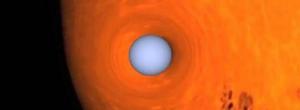Determining the Mass of the White Dwarf in KOI-3278 Using Two Different but Complimentary Techniques
A team of astronomers led by the Center for Astrophysics | Harvard & Smithsonian have updated and confirmed self-lensing binary star KOI-3278's companion to be a white dwarf star by pitting Einstein against Newton.

Koi-3278。
Discovered as the first self-lensing binary star system in 2014 by University of Washington scientists, KOI-3278’s behavior was originally reported as a result of microlensing based on periodic increases in brightness as the potential white dwarf companion passed in front of the G star, and dips in brightness as it passed behind the star.
"We decided to pursue follow-up spectroscopy of the binary system with the goal of observing the orbital motion of the G star. With these new observations, we then created an independent Newtonian dynamical model of the system to confirm the companion as a white dwarf," said Mr. Daniel Yahalomi, lead author of the paper. "This was a unique opportunity to independently apply Einsteinian and Newtonian gravitational theories to model the same binary system. We found a consistent set of predictions from these independent models, serving as another confirmation of these two gravitational theories."
The Einsteinian model explains the periodic bending, or lensing, of the light paths from the G star due to the gravitational field of the foreground white dwarf, as described by Einstein's theory of General Relativity. The Newtonian model explains the periodic Doppler shifts in the spectroscopic observations of the G star due to the gravitational pull of the white dwarf throughout its orbital motion, as described by Newton's law of Universal Gravitation.
The team took advantage of two independent campaigns to obtain and analyze spectra for the companion star using the High Resolution Echelle Spectrometer (HIRES) on the Keck I at Mauna Kea, and the Tillinghast Reflector Echelle Spectrograph (TRES) on the Tillinghast Reflector at the Fred Lawrence Whipple Observatory on Mount Hopkins in Arizona. The independent measurements yielded a difference in mass of just 5.2-percent, which is within the range of measurement uncertainty.
"Because the two independent approaches gave consistent results for the mass of the unseen companion, we gained confidence that although very different, both theoretical approaches are successful in explaining different aspects of gravity," said Dr. David Latham, Senior Astronomer at the CfA | Harvard & Smithsonian, and an author on the paper. "Opportunities to make direct determinations of white dwarf masses are rare, so this result for KOI-3278 is a valuable asset as we test theoretical models for other white dwarf stars."
For scientists, determining the model independent mass of a white dwarf allows for the anchoring of stellar evolutionary models. "These models describe the mass of stars at the end stages of their evolution," said Yahalomi. "By combining two observational techniques with two different gravitational theories we were able to remove all assumptions and models about white dwarfs, and determine the mass of the white dwarf. By doing so, we then can test the existing white dwarf models."
With these findings in hand, the team is busy working on follow-up observations of transiting planet candidates identified by the TESS mission, and searching for additional self-lensing binaries.
"We are hopeful that the TESS mission may provide evidence for other types of self-lensing binaries," said Yahalomi. "Now that we know a joint Einsteinian-Newtonian model can help us to predict the properties of white dwarfs, we can test it on other self-lensing binaries. It's a great example of how basic science helps us to understand how nature, and our universe, work and we are eager to see what happens next."
Source: Center for Astrophysics, Harvard & Smithsonian
- 223 reads
Human Rights
Ringing FOWPAL’s Peace Bell for the World:Nobel Peace Prize Laureates’ Visions and Actions

Protecting the World’s Cultural Diversity for a Sustainable Future

The Peace Bell Resonates at the 27th Eurasian Economic Summit

Declaration of World Day of the Power of Hope Endorsed by People in 158 Nations

Puppet Show I International Friendship Day 2020

